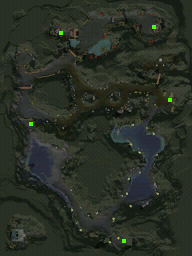
Thereafter, Greenwood the Great was the dwelling of the Wood-elves (the Nandor, Elves descending from the wandering Teleri Elf Lenwë) for many thousands of years. The Elves passed through it on their Great Journey from Cuiviénen into the Far West - it was where they made their first long stop before continuing onward. The forest that would become Mirkwood dates back to the earliest days of Middle-earth. During the events of The Hobbit it was home to giant spiders, and the kingdom of King Thranduil and his Wood-elves the Woodmen of Mirkwood also inhabited a small part of the forest. Mirkwood was approximately 600 miles long from north to south, and 250 miles across at its width. Except for ways through the thickets of the forest, there were very few common routes through Mirkwood save for the Old Forest Road and the Forest Path.

This smaller river was enchanted (or polluted) to such an extent that it caused slumber and forgetfulness to anyone who fell into it. Its natural land features included (in the northern part of the forest) the Mountains of Mirkwood, a sizable river referred to in Tolkien's map as the Forest River, that ran from the Grey Mountains down to Long Lake, and a smaller river that ran from the Mountains of Mirkwood to join with the Forest River west of the Elven-king's Halls. Mirkwood was a dense and heavy woodland that made up much of the eastern portion of Rhovanion or the Wilderland, that maintained its borders and relative shape for many ages.


Map of Mirkwood in Wilderland, from The Hobbit. 3.1 Peter Jackson's The Hobbit film trilogy.


 0 kommentar(er)
0 kommentar(er)
